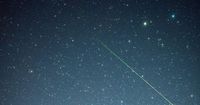For astronomy enthusiasts and casual stargazers alike, the summer sky has delivered a dazzling spectacle: the Perseid meteor shower. This annual celestial event, which began on July 17, 2025, is now entering its final days, offering a last chance for sky-watchers to catch nature’s fiery fireworks before the curtain falls on August 24. According to the Royal Observatory, the Perseids reached their most intense display on August 12, but breathtaking views are still possible through Sunday, with NASA hailing it as the "most popular meteor shower of the year."
Dr. Shyam Balaji, a theoretical physicist at King’s College London, echoed NASA’s enthusiasm, describing the Perseids as an "astronomical highlight" for stargazers everywhere. “The Perseid meteor shower is caused by the Earth travelling through the debris left by a comet called Swift-Tuttle,” Dr. Balaji explained, as reported by Bristol Live and multiple outlets. “The debris falls through the Earth's atmosphere and as it burns up you get the meteor shower display. It is one the fastest and brightest meteor showers of the year, so an astronomical highlight for stargazers.”
The science behind the Perseids is as fascinating as the spectacle itself. Each August, Earth’s orbit intersects with a trail of debris left behind by Comet Swift-Tuttle, a cosmic traveler whose legacy stretches back nearly 2,000 years in the human record. The meteors, astonishingly tiny—no larger than a grain of sand—hurtle through our atmosphere at a staggering 36 miles per second. As they incinerate on entry, they create brilliant streaks of light that have captivated observers for generations.
The Perseids are renowned not just for their frequency but also for their dramatic fireballs. These are no ordinary shooting stars; they’re distinguished by enormous flashes of light and color that linger longer in the sky than typical meteor trails. The shower draws its name from the Perseus constellation, believed to be the point of origin for these cosmic visitors. For those searching the heavens, the best viewing direction is toward the North East—right where Perseus, the Greek mythological hero, resides among the stars. Some say the constellation resembles the rough silhouette of a man’s figure, though that’s up for interpretation.
Visibility this year has been particularly promising, thanks in part to lunar conditions. Experts at Starwalk note that the Moon’s brightness on August 18 is only 26.9%, which means less interference from moonlight and a better chance of spotting even the faintest meteors. Still, a little strategy goes a long way. Dr. Balaji offers simple but effective advice: “The best place to view the Perseid meteor shower is in the North East near the constellation Perseus. While you can look at the whole sky and are likely to see a meteor, that's the target location in order to get the best viewing experience.”
What about equipment? It turns out, simplicity wins the night. “For me personally, the best way to view the meteor shower is just with your naked eye because of the speed with which they move,” Dr. Balaji noted. “But you could use Sky Guide or Stellarium or other stargazing apps to get a better viewing experience, to target the right regions of the sky to see the meteor shower.” These apps can help pinpoint the Perseus constellation, making it easier for even novice stargazers to orient themselves under the night sky.
As for the practicalities of meteor hunting, seasoned observers and institutions like the Royal Museums Greenwich emphasize preparation. “Plan ahead and check the weather forecast. If it is likely to be inclement, find a different location or go out on a different day. The days leading up to the peak are usually better than the days after,” their guidance reads. Weather, of course, remains the perennial wildcard—cloud cover can easily spoil the show, so flexibility is key.
Light pollution is the other major hurdle. The glow of city lights can drown out all but the brightest meteors, so experts recommend heading for the countryside, a local park, or any spot far from urban glare. Even turning your back to streetlamps can make a surprising difference if you’re stuck in town. The darker your surroundings, the more meteors you’re likely to catch streaking across the sky.
For those unable to escape the city, there’s still hope. With the Moon at less than a third of its full brightness, even urbanites stand a decent chance of seeing some action—especially if they follow Dr. Balaji’s advice and use a stargazing app to hone in on the right part of the sky. And remember, patience pays off. The Perseids are famous for their unpredictability; a lull can suddenly give way to a flurry of shooting stars.
The Perseid meteor shower’s long history adds to its mystique. Observed for nearly two millennia, the event has inspired awe across cultures and continents. Each year, as Earth plows through the ancient debris field of Comet Swift-Tuttle, it’s a reminder of our planet’s place in the broader cosmos—a brief, beautiful intersection with the remnants of a comet hundreds of times older than human civilization itself.
For many, witnessing the Perseids is more than just a scientific curiosity. It’s a chance to connect with nature, to marvel at the universe’s grandeur, and perhaps to make a wish on a shooting star. As NASA and experts like Dr. Balaji remind us, the Perseids are not just the most popular meteor shower of the year—they’re a highlight of the astronomical calendar, eagerly anticipated by seasoned astronomers and first-time sky-watchers alike.
With only a few nights left before the Perseids fade from view, now’s the time to grab a blanket, find a dark spot, and look up. Whether you catch a solitary streak or a spectacular fireball, you’ll be joining a tradition that stretches back thousands of years—and you might just find yourself awestruck by the wonders above.




